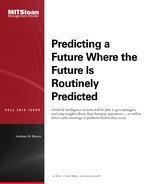Predicting a Future Where the Future Is Routinely Predicted
Artificial intelligence systems will be able to give managers real-time insights about their business operations — as well as detect early warnings of problems before they occur.
Editor’s Note: This article is one of a special series of 14 commissioned essays MIT Sloan Management Review is publishing to celebrate the launch of our new Frontiers initiative. Each essay gives the author’s response to this question:
“Within the next five years, how will technology change the practice of management in a way we have not yet witnessed?”
Workers on the factory floor have suddenly gathered at a point along the production line. Some are scratching their heads. Others are gesticulating wildly. Most stand with their hands in their pockets. Something is wrong, and no one has thought to call management.
In the near future, scenes like this one will be obsolete. Thanks to advances in artificial intelligence (AI), managers will be alerted to workplace anomalies as soon they occur. Unusual behaviors will be identified in real time by cameras and image-processing software that continuously analyze and comprehend scenes across the enterprise.
The hunch-based bets of the past already are giving way to far more reliable data-informed decisions. But AI will take this further. By analyzing new types of data, including real-time video and a range of other inputs, AI systems will be able to provide managers with insights about what is happening in their businesses at any moment in time and, even more significantly, detect early warnings of bigger problems that have yet to materialize.
As a researcher, I learned to appreciate the value of early warnings some years ago, while developing algorithms for analyzing data from hospital emergency rooms and drugstores. We discovered that we could alert public health officials to potential epidemics and even the possibility of biological warfare attacks, giving them time to take countermeasures to slow the spread of disease.
Similar analytic techniques are being deployed to detect early signs of problems in aircraft. The detailed maintenance and flight logs for the U.S. Air Force’s aging fleet of F-16 fighter jets are analyzed automatically to identify patterns of equipment failures that may affect only a handful of aircraft at present, but have the potential to become widespread. This has enabled officials to confirm and diagnose problems and take corrective action before the problems spread.
With AI, we can have machines look for millions of worrying patterns in the time it would take a human to consider just one. But that capability includes a terrible dilemma: the multiple hypotheses problem. If you sound an alarm whenever something is anomalous at a 99% confidence level, and you check millions of things an hour, then you will receive hundreds of alarms every minute.
Statisticians and AI researchers are working together to identify situations and conditions that tend to sound false alarms, like a truckload of potassium-rich bananas that can set off a radiation detector meant to identify nuclear materials. By reducing the risk of false alarms, it will be possible to set sensor thresholds even lower, enhancing sensitivity.
The predictive benefits of AI will stretch well beyond equipment and process analysis. For instance, researchers are having great success with algorithms that closely monitor subtle facial movements to assess the emotional and psychological states of individuals. Some of the most interesting applications now are in the mental health sphere, but imagine if the same tools could be deployed on checkout lines in stores, lines at theme parks, or security queues at airports. Are your customers happy or agitated? Executives wouldn’t need to wait weeks or even days for a survey to be completed; these systems could tell you the emotional state of your customers right now.
Other researchers are deploying AI in the classroom. When I taught, I couldn’t tell whether the lecture I was giving was any good — at least not when it would still benefit me or my students. But simple sensors like microphones and cameras can be used by AI programs to detect when active learning is taking place. Just the sounds alone — Who’s talking? Who isn’t? Is anyone laughing? — can provide a lot of clues about teaching effectiveness and when adjustments should be made.
Such a tool could also be used to gauge whether your employees are buying in to what you’re sharing with them in a meeting, or if potential customers are engaged during focus groups. A “managerial Siri” might take this even further. If you asked your digital assistant, “Do the folks in my staff meeting seem to be more engaged since we had the retreat?” you might receive an answer such as, “Yes, there is an increase in eye contact between team members and a slight but significant increase in laughter.”
As a manager, I absolutely detest being surprised. And like everyone else, despite the petabytes of data at my fingertips, I too often am. But AI doesn’t get overwhelmed by the size and complexity of information the way we humans do. Thus, its promise to keep managers more in the know about what’s really happening across their enterprise is truly profound.
Andrew W. Moore is dean of the School of Computer Science at Carnegie Mellon University in Pittsburgh, Pennsylvania.
Reprint 58108.
For ordering information, visit our FAQ page. Copyright © Massachusetts Institute of Technology, 2016. All rights reserved.
